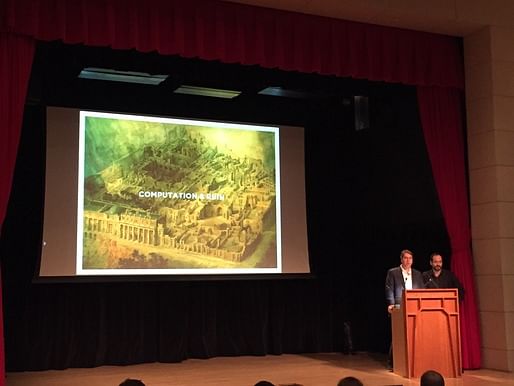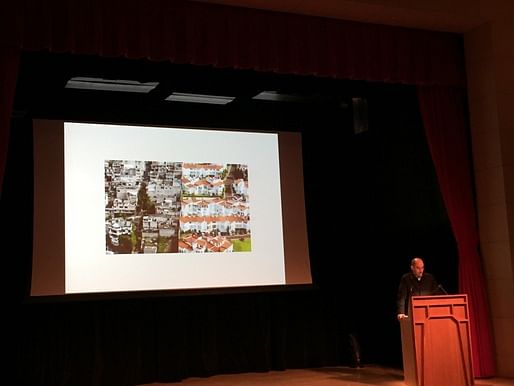

Last Thursday, the Architectural League of New York launched its 2015 Emerging Voices lecture series with firms Aranda\Lasch and MANUEL CERVANTES CESPEDES / CC ARQUITECTOS. Architects Benjamin Aranda, Chris Lasch and Manuel Cervantes Cespedes presented a survey of their work, ranging through a wide array of scales and site locations.
All three architects grounded their work in an extensive description of their process and research methodologies that influence the forms and logic of their individual projects. Both firms seem to have rooted their work in interdisciplinary explorations, adding diversity to their architectural approach.
Lasch framed the firm’s work: “It is about patterns, math and science, but its also about history – there seems to be an obsession about historical objects.” The firm’s projects each have a historical lineage, particularly a grotto they designed using only four modular boulders, inspired by the typology of the Romantic grotto. Projects like their 1774 chair (named for the year Louis XV died), and the crystal inspired projects are similar extrapolations of historical moments. In the words of Lasch, “It’s about continuing a narrative.”

Lasch emphasized this idea of continuity with a story about scientist Dan Shechtman, whose discovery of the quasicrystal structural pattern has played a central role in the form-finding and pattern-making that Aranda\Lasch pursue, whether in their furniture or installations: “We strive to make universal themes very specific,” said Lasch. Another link in Lasch’s chain is the early snowflake photography of Wilson Bentley, and the discovery of six-fold symmetry in snowflakes. “The driving rule of six became a generating element,” said Lasch, drawing the snowflake tangent into the design the Rules of Six installation. Fractals continue to influence their work in projects like The Morning Line, a modular installation that is disassembled and reassembled in different cities, each time taking on a new organization, “each piece is a self-contained tectonic.”
Lasch pointed to their 20 Bridges for Central Park project a complete encapsulation of their ideas: “You can kind of see it all come together, the quasicrystal, fractal and single building elements.” Aranda topped the presentation by comparing today’s obsession with computation and parametrics with the dawn of the industrial revolution, criticizing architecture’s tendency to idealize ruins in the process: “Computation is destructive to the discipline of architecture in a good way… Computation did to the physical world what ruins did with time, the ruin was a freedom to rebuild and computation does the same.”
Aranda explained the firm’s more architectural projects pick up at this stage, as they “atomize components to build something new.” He concluded with “If this is the age of makers we like the idea of being ruiners, where we atomize the components of a project to build them up to something new.”

Manuel Cervantes Cespedes, an architect in Mexico City, mentioned similar historical inspirations but emphasized his focus on culture and urban development. He began his lecture with a description of the architectural ethos in Mexico, describing a complicated and growing urban system. “In order to understand our country, we need to understand how we got here.” Starting with paintings by Diego Rivera, it was refreshing to learn how the architect was trying to embed his work within a historical context. “Our society is also complex, it has a huge contrast, a social and economic contrast,” Cespedes explained – factors which became very apparent in the varying clients and uses of his projects.
One of many TODs Cespedes is currently working on, his El Rosario project is an attempt “to work with existing infrastructure” to create more efficient spaces in dense Mexico City. Key to the project is creating space for people who work in Mexico City to move from the suburbs back into the city, using existing public transportation systems. El Rosario is an integral hub for bridging the desires of unknown tenants, clients and the government.
Concluding with his design for a Hydroponic Plant, Cespedes tied his firm’s intentions together: simple spaces in series can harmonize elements of architecture and landscape, of light and space.
No Comments
Block this user
Are you sure you want to block this user and hide all related comments throughout the site?
Archinect
This is your first comment on Archinect. Your comment will be visible once approved.